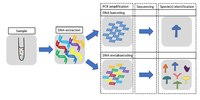
Photo from wikipedia
Abstract Macroinvertebrates are sensitive to changes in the river environment and ecological status. Ecological variables over multi-spatial scales and macroinvertebrate community data were collected in June (normal flow season) and… Click to show full abstract
Abstract Macroinvertebrates are sensitive to changes in the river environment and ecological status. Ecological variables over multi-spatial scales and macroinvertebrate community data were collected in June (normal flow season) and September (high flow season) of 2017 in the Weihe River Basin (WRB). A total of 14,377 individuals were identified, which were classified into 7 classes, 18 orders and 59 families. Macroinvertebrate community composition, density, biomass, the values of Pielou evenness index (E), Simpson diversity index (λ) were significantly different between normal flow season and high flow season. The dominant species (Tubificidae, Chironomidae and Baetidae) were the same in both seasons. The highest richness, abundance, density and biomass occurred at a stream bed depth of 0–10 cm. The results of canonical correspondence analyses (CCA) showed that ecological factors explained the major variation in macroinvertebrate community composition. Specifically, the increased nitrogen concentrations favored tolerant species, whereas high velocity and dissolved oxygen (DO) benefitted community taxa richness and biodiversity. The reduction of taxa richness, abundance, density and biomass in high flow season was related to the summer flood. Increased nutrient concentrations and macroinvertebrate habitat damage contributed to more tolerant, yet less diverse stream macroinvertebrate assemblages.
Journal Title: Ecological Engineering
Year Published: 2019
Link to full text (if available)
Share on Social Media: Sign Up to like & get
recommendations!